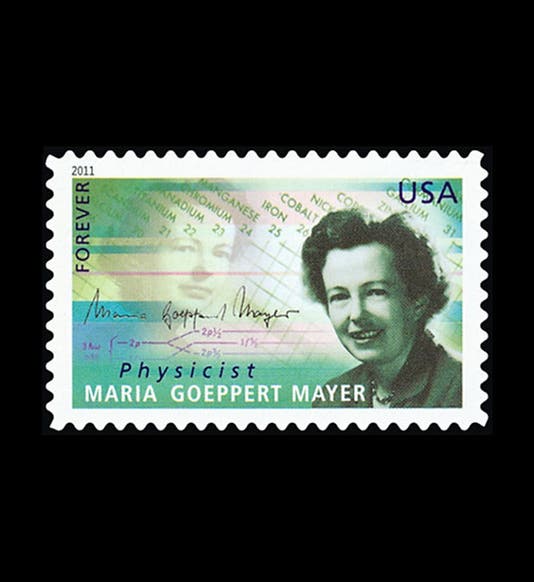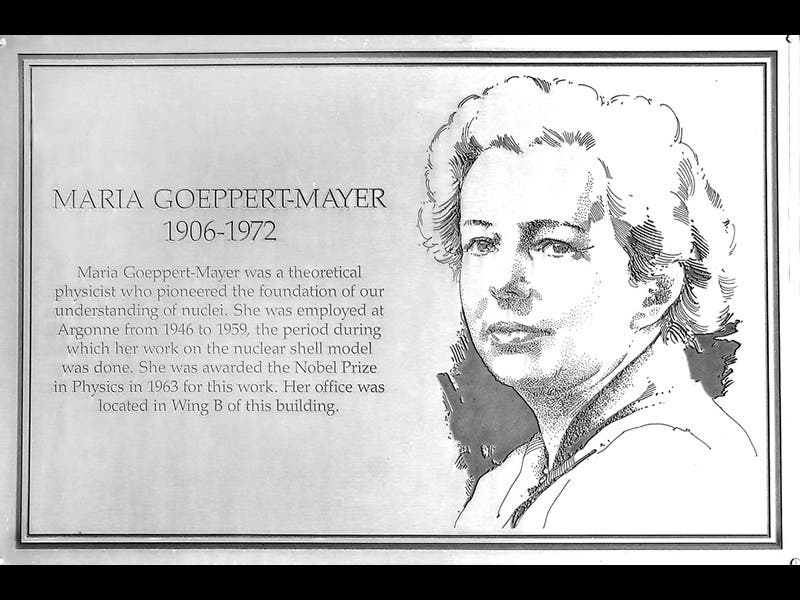Scientist of the Day - Maria Goeppert Mayer
Maria Goeppert Mayer, a German/American physicist, was born June 28, 1906. Maria studied physics at the University of Göttingen, where she met her husband, a physical chemist, and the two moved to the United States in 1939. Her husband found a position at Johns Hopkins University, but they had rules against hiring spouses, so Maria taught without pay, both at Hopkins and at their next stop, Columbia University. It was in New York City that Maria met Enrico Fermi and became involved in the Manhattan Project, and then she moved with her husband to the University of Chicago when Fermi moved there in 1945. Still unable to secure a bonafide academic position at Chicago, she found a consulting job with nearby Argonne National Laboratory, and it was here that she made her great discovery, the shell structure of the atomic nucleus.
The standard model of nuclear structure at the time was the "liquid drop" model, which was useful in explaining the newly-discovered phenomenon of nuclear fission. But Goeppert Mayer wondered why certain configurations of protons and neutrons were particularly stable--namely nuclei with 2, 8, 20, 28, 50, 82, or 126 protons or neutrons--while others were noticeably less stable. The liquid drop model provided no explanation. In 1948, she proposed that protons and neutrons occupied energy shells just like the electrons in the atom.
Because of Pauli's exclusion principle, only one particle in the nucleus could be in a particular energy state, but because of differences in spin, orbital inclination, and momentum, there were a number of energy states available in a particular shell. When that shell was filled, it was very difficult to add or subtract particles, making the nucleus quite resistant to change, and this occurred, Goeppert Mayer found, when there were 2, 8, 20, 28, 50, 82, or 126 nucleons. Goeppert Mayer took a crucial step, so she said, when Fermi suggested that the spin of nucleons might somehow be coupled with their orbital momentum, which Goeppert immediately recognized as necessary and true, and she rapidly (that very night, she said) worked out the final details of her proposed structure. It was published in stages in the journal Physical Review in 1948, 1949, and 1950.
For her work on the nuclear shell model, Goeppert Mayer was awarded the Nobel Prize in Physics in 1963, the first woman since Marie Curie (and the last) to receive that award. She shared the prize with Hans Jensen, who independently discovered the shell model in Germany, and Eugene Wigner. By that time, Goeppert finally held a genuine, fully-paid professorship at the University of California at Berkeley.
They are very proud of Goeppert Mayer at Argonne National Lab and have erected a plaque in her honor (third image). She was also chosen to be included in the American Scientists series of postage stamps in 2011; above we see her individual stamp (first image) and a block of four that includes the other honorees: Asa Gray, Severo Ochoa, and Melvin Calvin (second image).
Dr. William B. Ashworth, Jr., Consultant for the History of Science, Linda Hall Library and Associate Professor, Department of History, University of Missouri-Kansas City. Comments or corrections are welcome; please direct to ashworthw@umkc.edu.






![“Aurora Borealis,” hand-colored wood engraving by Josiah Wood Whymper, [Natural Phenomena], plate 2, 1846 (Linda Hall Library)](https://assets-us-01.kc-usercontent.com:443/9dd25524-761a-000d-d79f-86a5086d4774/0245ffcb-b70c-477c-8792-0a73ebd54eb2/Whymper%2011.jpg?w=210&h=210&auto=format&fit=crop)


